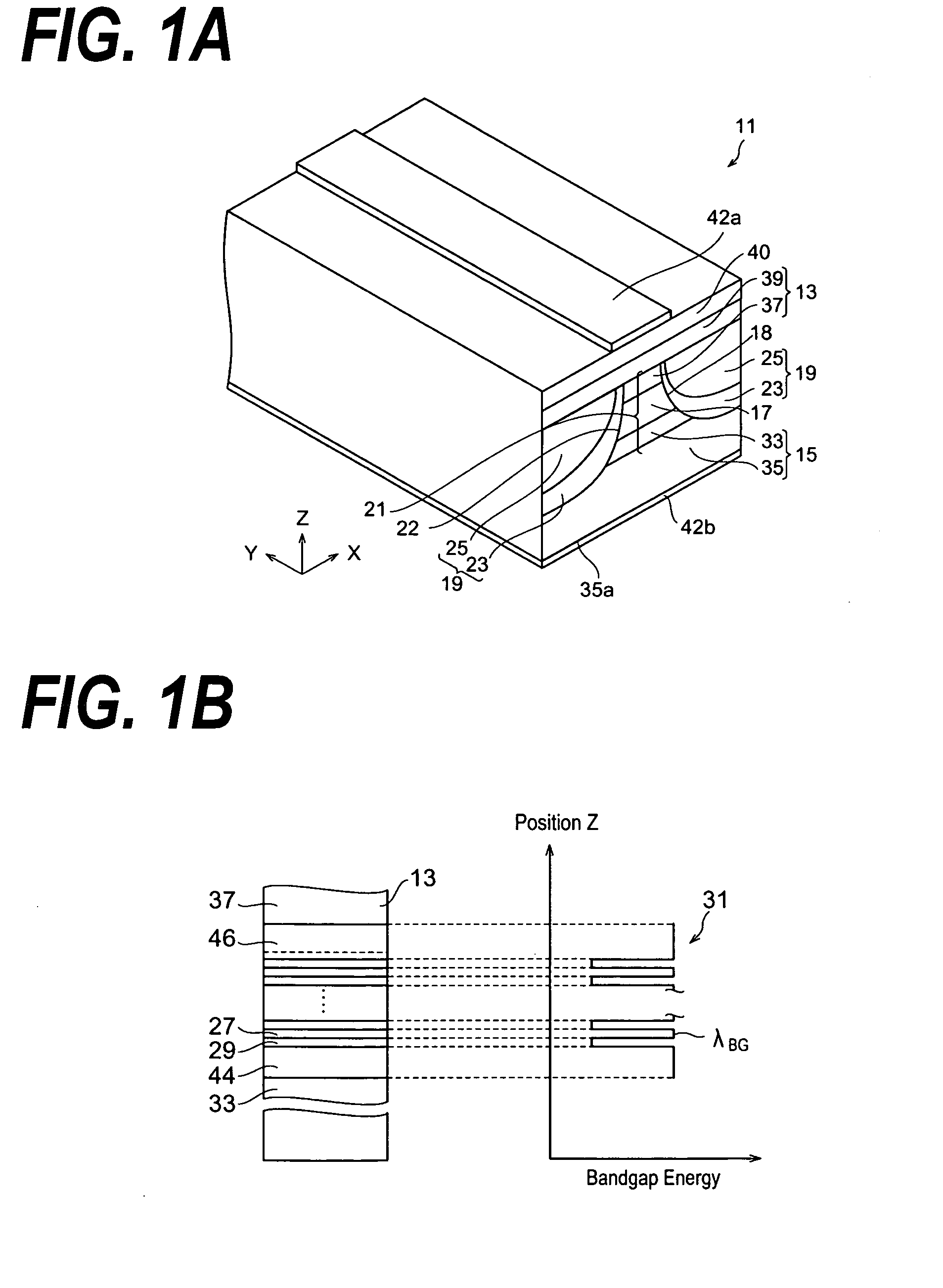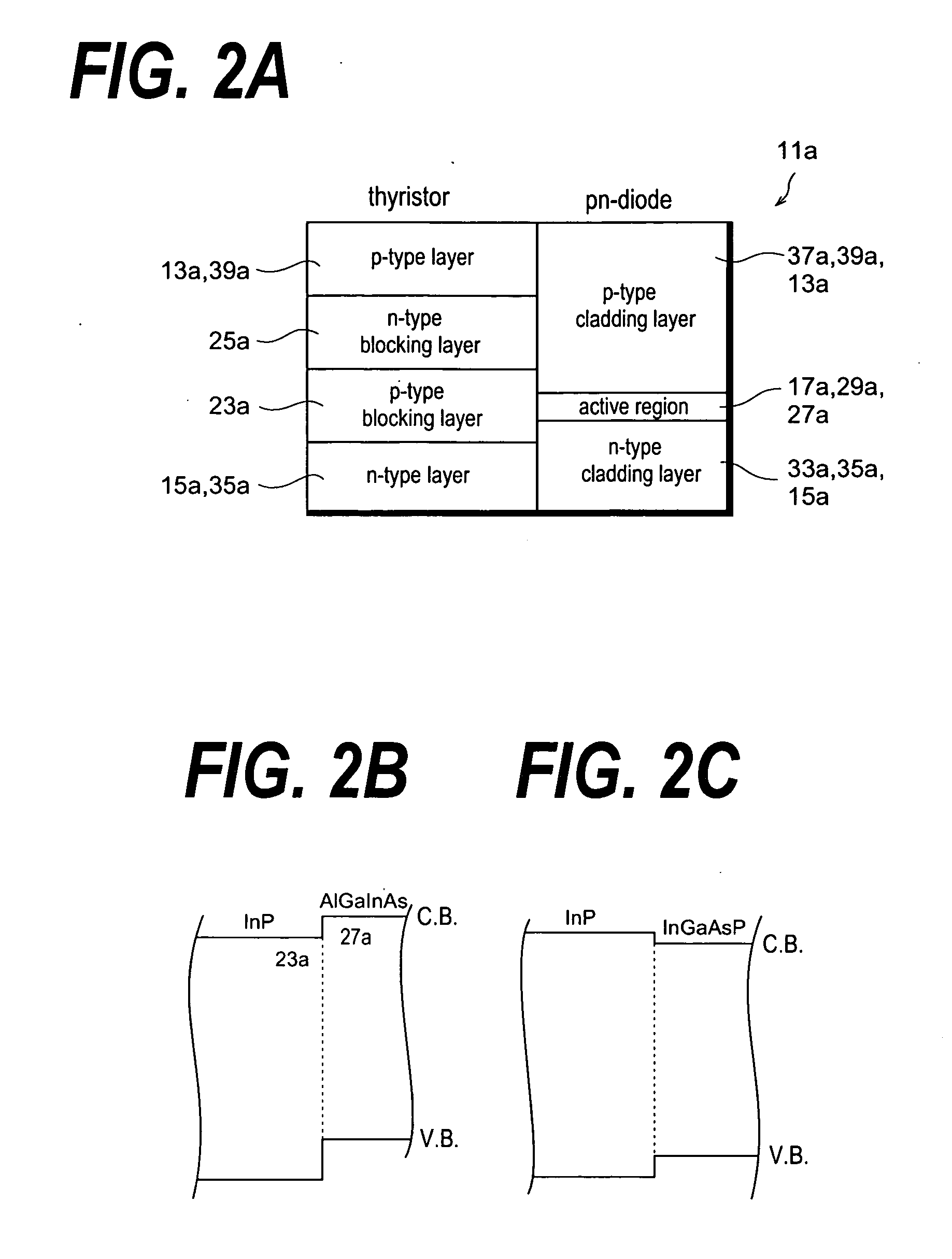Semiconductor light-emitting device
- Summary
- Abstract
- Description
- Claims
- Application Information
AI Technical Summary
Benefits of technology
Problems solved by technology
Method used
Image
Examples
Example
[0026]FIG. 1A shows a light-emitting device according to the first embodiment of the invention, and FIG. 1B schematically shows a structure in the active region of the light-emitting device shown in FIG. 1A. The light-emitting device 11 has a semiconductor region 13 with a second conduction type, a semiconductor region 15 with a first conduction type, an active region 17, and a buried semiconductor region 19. The active region 17 is put between the region 13 with the second conduction type and the region 33 with the first conduction type, and is within the mesa 21. The buried region 19, also put between the region 13 with the second conduction type and the region 15 with the first conduction type, and covers the side 22 of the mesa 21 and the top of the region 15 with the first conduction type. The buried region 19 includes a buried layer 23 with the second conduction type and another buried layer 25 with the firs conduction type. The former layer 23, the buried layer with the secon...
Example
Second Embodiment
[0037] The second embodiment of the present invention has a first III-V semiconductor material for the barrier layer with a tensile stress. The light-emitting device 11 according to the second embodiment, because the bottom level of the conduction band in the barrier layer may be lowered, the leak current flowing in the current blocking layer may be further reduced. Moreover, the well layer 29 may have a second III-V semiconductor material with a compressive stress to compensate the tensile stress in the barrier layer.
[0038] An example of layer configurations in the active region 17 according to the second embodiment will be shown in FIG. 11. This example is a type of the compressive stress in the well layers, while, the tensile stress in the barrier layers.
[0039] The lattice mismatching Δa / a in the well layers is greater than or equal to −1.5% and is smaller than or equal to −0.7%, where a is the lattice constant of the InP, while Δa is a difference in the latti...
Example
Third Embodiment
[0054] Next, a method for manufacturing a light-emitting device according to the present invention will be described as referring to FIGS. from 8A to 9C. In FIG. 8A, an n-type InP substrate 41 is prepared. A series of films is grown on this InP substrate 41, that is, a cladding film 43 made of an n-type InP, a lower separated-confinement-hetero-structure (SCH) film 45 made of an AlGaInAs, a multi-quantum well (MQW) region 47, an upper SCH film 49 made of an AlGaInAs, and a cladding film 51 made of a p-type InP, are grown on the InP substrate in this order. The growth of these films may be carried out in the apparatus of the Organo-Metallic Vapor-phase Epitaxy (OMVPE) technique. The MQW region 47 includes a barrier film made of the AlGaInAs with a band gap wavelength thereof greater than or equal to 1.05 μm and smaller than or equal to 1.15 μm, and a well film with a band gap wavelength longer than that of the barrier film, for example, 1.4 μm.
[0055] As shown in FIG...
PUM
 Login to View More
Login to View More Abstract
Description
Claims
Application Information
 Login to View More
Login to View More - R&D
- Intellectual Property
- Life Sciences
- Materials
- Tech Scout
- Unparalleled Data Quality
- Higher Quality Content
- 60% Fewer Hallucinations
Browse by: Latest US Patents, China's latest patents, Technical Efficacy Thesaurus, Application Domain, Technology Topic, Popular Technical Reports.
© 2025 PatSnap. All rights reserved.Legal|Privacy policy|Modern Slavery Act Transparency Statement|Sitemap|About US| Contact US: help@patsnap.com



